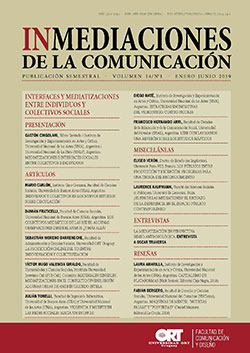The Online Projection of the Self between Individuation and Collectivization
DOI:
https://doi.org/10.18861/ic.2019.14.1.2886Keywords:
self-representation, digital culture, identity, semiotics, InstagramAbstract
The practices related to the projection of personal identity that are carried out on digital media can and should be conceived as practices of communication and, more widely, signification. From a semiotic approach, such practices could be understood as strategies of enunciation of the self in which individuals, by means of creative acts that imply the manipulation of the dimension of the expression, consciously or unconsciously manage the image they project to the external world with strategic goals, aiming at producing a specific effect of sense in how the others conceive them. The goal of this paper is to present an argument that can help conceiving the identity projection practices that take place online as the result of the employment of a series of semiotic resources and that are based on a dynamic that permanently oscillates between two poles: individuation and collectivization. As it happens with every process of identity construction, the online projection of personal identity reflects this inescapable necessity of the collective dimension in order to affirm what is individual and unique. The theoretical proposal is illustrated by the discussion of some examples of how individuals create their individual personal profiles on Instagram.
Downloads
References
Anderson, B. (1983). Imagined communities. London: Verso.
Arfuch, L. (ed.) (2005). Identidades, sujetos, subjetividades. Buenos Aires: Prometeo.
Berger, P. & Luckmann, T. (1966). The Social Construction of Reality. London: Penguin.
Bucholtz, M. & Hall, K. (2005). Identity and interaction: a sociocultural approach. Discourse Studies, 7(4-5), 585-614.
Bullingham, L. & Vasconcelos, A. (2013). The presentation of self in the online world: Goffman and the study of online identities. Journal of Information Science, 39(1), 101-112.
Burke, P. J. & Stets, J. E. (2009). Identity Theory. Oxford: Oxford University Press.
Coupland, N. (2007). Style. Language Variation and Identity. Cambridge: Cambridge University Press.
De Certeau, M. (1978) L’invention du quotidien, 1: Arts de faire. París: Gallimard.
Danesi, M. (2016). The Semiotics of Emoji. London: Bloomsbury.
Deeb-Swihart, J. et al. (2017). Selfie-Presentation in Everyday Life: A Large-scale Characterization of Selfie Contexts on Instagram. Association for the Advancement of Artificial Intelligence. Recuperado de: https://www.cc.gatech.edu/~irfan/p/2017-Deeb-Swihart-SELLCSCI.pdf Consultado: 21/03/2019
Dondero, M. G. (2017). Du texte à la pratique: Pour une sémiotique expérimentale. Semiotica 2017. Recuperado de : https://doi.org/10.1515/sem-2017-0081 Consultado: 21/03/2019
Eco, U. (1975). Tratado de semiótica general. Barcelona: Lumen.
Floch, J. M. (1986). Les formes de l’empreinte. París: Pierre Fanlac.
Floch, J. M. (1990). Sémiotique, marketing et communication. París: Presses Universitaires de France.
Floch, J. M. (1995). Identités visuelles. París: Presses Universitaires de France.
Fontanille, J. (2016). Análisis del curso de acción de las prácticas. Contratexto, 25, 127-152.
Fontanille, J. (2015). Formes de vie. Lieja: Presses Universitaires de Liège.
Fontanille, J. (2013). Medios, regímenes de creencia y formas de vida. Contratexto, 21, 65-82.
Fontanille, J. (2008). Pratiques sémiotiques. París: Presses Universitaires de France.
Fornäs, J. (2017). Defending culture. Conceptual foundations and contemporary debate. London: Palgrave/Macmillan.
García Canclini, N. (1999). La globalización imaginada. Buenos Aires: Paidós.
Geertz, C. (1973). The Interpretation of Cultures. New York: Basic Books.
Goffman, E. (1959). La presentación de la persona en la vida cotidiana.
Buenos Aires: Amorrortu.
Gómez García, P. (2012). Las ilusiones de la identidad. Madrid: Cátedra.
Hess, A. (2015). The selfie assemblage. International Journal of Communication, 9, 1629-1646.
Hofstede, G. et al. (2010). Cultures and Organizations. New York: McGraw-Hill.
Hogan, B. (2010). The Presentation of Self in the Age of Social Media: Distinguishing Performances and Exhibitions Online. Bulletin of Science, Technology & Society, 30(6), 377-386.
Jaspers, J. (2006). Stylizing Standard Dutch by Moroccan boys in Antwerp. Linguistics and Education, 17, 131-156.
Lejeune, P. (1996). Le pacte autobiographique. París: du Seuil.
Lorusso, A. M. (2010). Semiotica della cultura. Roma-Bari: Laterza.
Maalouf, A. (1998). Les identités meurtrières. París: Grasset.
Marrone, G. (2018). Prima lezione di semiotica. Bari-Roma: Laterza.
Paccagnella, L. & Vellar, A. (2016). Vivere online. Identità, relazioni, conoscenza. Bolonia: Il Mulino.
Papacharissi, Z. (2002). The presentation of self in virtual life: Characteristics of personal home pages. Journalism & Mass Communication Quarterly, 79(3), 643-660.
Rettberg, J. W. (2014). Seeing Ourselves Through Technology: How We Use Selfies, Blogs and Wearable Devices to See and Shape Ourselves. Basingstoke: Palgrave/Macmillan.
Schulman, D. (2016). The Presentation of the Self in Contemporary Social Life. London: Sage.
Searle, J. (1995). The Construction of Social Realtity. London: Penguin.
Sibilia, P. (2008). La intimidad como espectáculo. Buenos Aires: Fondo de Cultura Económica.
Thumim, N. (2012). Self-Representation and Digital Culture. London: Palgrave/Macmillan.
Turkle, S. (2011). Alone Together. New York: Basic Books.
Vigild Poulsen, S. et al. (2018). Special issue: Social media as semiotic technology. Social Semiotics, 28(5), 593-600.
Williams, R. (1976). Keywords. A Vocabulary of Culture and Society. New York: Oxford University Press.
Zhao, S. et al. (2008). Identity construction on Facebook: Digital empowerment in anchored relationships. Computers in Human Behavior, 24(5), 1816-1836.





